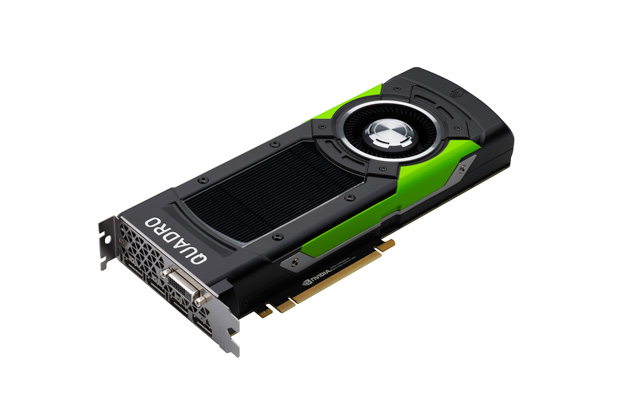Editor’s Pick: NVIDIA Quadro GPUs

NVIDIA says it designed its new Quadro P6000 GPU “to power the most advanced workstations ever built.” Image courtesy of NVIDIA Corp.
Latest News
August 31, 2016
NVIDIA has been a busy outfit lately. During the SIGGRAPH Conference and Exhibition at the end of July, it had a bevy of new product announcements. Among these were enhancements to its mental ray renderer, extensions to its VRWorks 360 Video SDK for VR (virtual reality) software developers and a new release of its NVIDIA Optix 4 GPU ray-tracing engine. And then there was the announcement that is today’s Pick of the Week. It’ll interest designers, analysts, engineers, VR developers and scientists working with complex visualizations.
The short of it is that NVIDIA plans a fall roll-out of two new high-end GPUs (graphics processing units) based on its Pascal GPU architecture. Respectively, these are the Quadro P6000 and the Quadro P5000. The Pascal architecture is engineered for blazing your way through intensive visual computing applications like CAD, CAM, VR and engineering and scientific visualization. And these GPUs are designed to leverage Pascal to the nth degree.Take the top-of-the-line Quadro P6000. According to the results of benchmark tests that NVIDIA ran on it, this GPU can deliver up to 80% faster performance over previous generation GPUs. Now even if you only get double the boost, you’re talking screaming performance.
The Quadro P6000 has some impressive specs. For example, it has 3840 parallel-processing cores, 12 teraflops (TFLOPs) of 32-bit floating point (FP 32) performance and 24GB of GDDR5X (double data rate type five synchronous graphics RAM) graphics memory. GDDR5X memory is the next generation of the GDDR5 graphics memory standard. Among its key characteristics is a per pin data transfer rate that targets a speed that’s twice as fast than its predecessor.
The, ahem, more subdued Quadro P5000 GPU offers 2560 parallel-processing cores, 8.9 TFLOPs of FP 32 performance and 16GB of GDDR5X memory. Both GPUs have four DisplayPort connectors.
What either of these GPUs mean for you is that the Quadro P6000 and the Quadro P5000 could reset your expectations for graphics performance. Incidentally, Dell, HP and Lenovo plan to offer these GPUs in their workstation product line-ups.
 NVIDIA says it designed its new Quadro P6000 GPU “to power the most advanced workstations ever built.” Image courtesy of NVIDIA Corp.
NVIDIA says it designed its new Quadro P6000 GPU “to power the most advanced workstations ever built.” Image courtesy of NVIDIA Corp.You can learn some more about the Quadro P6000 and the Quadro P5000 GPUs from today’s Pick of the Week write-up. Hit the link at the end. From there you can sign up to be notified when these GPUs are generally available. You’ll also find a link so that you can learn what the Pascal architecture is about.
Thanks, Pal. – Lockwood
Anthony J. Lockwood
Editor at Large, DE
Subscribe to our FREE magazine, FREE email newsletters or both!
Latest News
About the Author
Anthony J. Lockwood is Digital Engineering’s founding editor. He is now retired. Contact him via [email protected].
Follow DE






